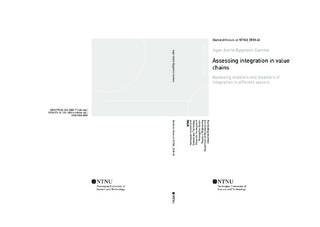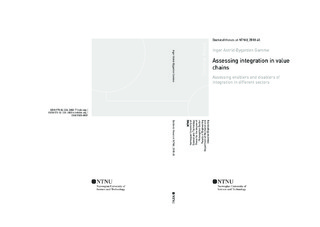| dc.contributor.advisor | Andersen, Bjørn | |
| dc.contributor.advisor | Martinsen, Kristian | |
| dc.contributor.author | Gamme, Inger Astrid Øygarden | |
| dc.date.accessioned | 2018-02-15T09:01:50Z | |
| dc.date.available | 2018-02-15T09:01:50Z | |
| dc.date.issued | 2018 | |
| dc.identifier.isbn | 978-82-326-2883-4 | |
| dc.identifier.issn | 1503-8181 | |
| dc.identifier.uri | http://hdl.handle.net/11250/2484897 | |
| dc.description.abstract | Organizations currently face increasing and ever-changing demands from their environments, which forces them to continuously aim to improve their value chain. This increasing requirement of their environments, together with the demand for greater product/service adjustments requires more flexible and adaptable value streams. Success criteria for organizations are the ability to respond quickly to demands from interested parties and, more importantly, the ability to adjust to future needs, which requires that they control the integration between different actors and units in today's complex organizations.
Organizations within the health sector and the automobile, service and craft sectors encounter different challenges, but must all aim for an adaptable and efficient value chain that delivers the best quality for the patient or customer. Despite many years of research on the topic of integration, and the many different terms and definitions that exist, researchers continue to call for more research on the topic to develop a more thorough and consistent understanding of it. Given this inconsistency within the field, the aim of this research is to provide clarification and a holistic understanding of the cross-functional integration in a value chain.
By raising five research questions, this PhD thesis contributes to an increased understanding of the topic of integration by studying what enables and disables integration, and which mechanisms are used to facilitate integration in five different organizations within different sectors in Norway. The case-studies in examining the value-adding element of the value chain are a hospital, two mass producers, a service provider and a craft producer, all of which are in Norway. The research data are based on semi-structured interviews with selected persons from different levels within the companies, as well as on observations, document reviews and participation in meetings. Based primarily on operation management and organization theory, the main purpose of this thesis is to extend existing knowledge identifying the enablers and disablers of integration within the value chain for different sectors.
The research supports what is claimed by the literature, namely that integration is a complex and multidimensional concept in which the output of a process is dependent on the relationship between many different mechanisms such as management support, culture, facility and layout, formalization and standardization, measurements and rewards, information systems, and consensus integration.
The research data support what researchers emphasize, namely that management plays an important role in achieving integration. Furthermore, cultural factors such as functional silo thinking and trust in or compliance with standards are identified as having an impact on other mechanisms such as consensus integration and formalization, as well as standardization. One less obvious finding regards the fact that functional silos were experienced at organizations with very different sizes and layouts. Even the smallest partitions were identified as contributing in the creation of functional silo thinking amongst employees. Even though some of the organizations dedicated some effort into transferring the overall strategy down to functional measures, the research data nevertheless indicated a mismatch between the overall goal and the functional focus. The literature cautions that unaligned bonuses could contribute to the creation of functional silos, as is supported by this research.
Another objective of this thesis is to build knowledge about what type of facilitators are used within the different organizations and how the use of these facilitators differs or is similar within different sectors. Based on both the theoretical and empirical findings on what is perceived to affect integration in value chains and what has been done to facilitate integration, a framework for maturity mapping of integration is suggested. This assessment framework provides guiding statements and questions to enable a rating of the degree of integration of the value chain, and further suggests a relationship between the mechanisms.
This relationship framework is intended to act as a guide for practitioners who seek to improve the integration of their value chain by taking actions on one or more mechanisms and who need to determine what possible mechanisms could be influenced by this action(s). Hence, this framework may contribute as guidance for practitioners who struggle to achieve an integrated value chain.
The results of this thesis provide several contributions to existing research. Firstly, this thesis provides supplementary theoretical insight into the topic of integration by providing an improved clarification of the topic. Unlike much research that focusses on integration within one single value chain, this dataset provides data from a broader set of sectors: a craft producer, two mass producers, a hospital and a financial service provider. Moreover, while earlier research is to a large extent based on surveys, this study offers empirical results from five case studies and responds to the call for more empirical studies.
The practical contribution of this thesis is an increased understanding of what employees within different value chains experience as contributing to or hindering integration. Furthermore, for practitioners within similar types of organizations, this thesis may contribute new insights which enablers, disablers and facilitators may consider if they aim to enhance value-chain integration. Finally, the framework that is proposed within this thesis may assist practitioners in evaluating the degree of integration of their value chain and further provide guidance on how possible actions may influence value-chain integration. | nb_NO |
| dc.language.iso | eng | nb_NO |
| dc.publisher | NTNU | nb_NO |
| dc.relation.ispartofseries | Doctoral theses at NTNU;2018:45 | |
| dc.relation.haspart | Paper 1:
Gamme, Inger Astrid Øygarden; Seim, Eva Amdahl; Lodgaard, Eirin Anita; Andersen, Bjørn Sørskot.
Operational integration in a craft-oriented small enterprise. The TQM Journal 2017 ;Volum 29.(2) s. 240-256
- Is not included due to copyright available at
https://doi.org/10.1108/TQM-01-2015-0009 | |
| dc.relation.haspart | Paper 2:
Gamme, Inger; Larsson, Catrine Eleonor.
Enablers and Disablers for Operational Integration in a Craft Oriented- versus a Mass Production Enterprise. I: Advances in production management systems : innovative and knowledge-based production management in a global-local world : IFIP WG 5.7 International Conference, APMS 2014, Proceedings, Part I. Springer
- Is not included due to copyright available at
https://doi.org/10.1007/978-3-662-44739-0_27 | |
| dc.relation.haspart | Paper 3:
Gamme, Inger; Berg, Geir Vegard.
Operational Integration in Health Care versus Mass Production. Quality, Innovation, Prosperity 2016 ;Volum 20.(1) s. 1-17 | |
| dc.relation.haspart | Paper 4:
Gamme, Inger; Aschehoug, Silje Helene.
Assessing lean’s impact on operational integration. International Journal of Quality and Service Sciences 2014 ;Volum 6.(2-3) s. 112-123
- Is not included due to copyright available at
https://doi.org/10.1108/IJQSS-02-2014-0013 | |
| dc.title | Assessing Integration in Value Chains - Assessing enablers and disablers of integration in different sectors | nb_NO |
| dc.type | Doctoral thesis | nb_NO |
| dc.subject.nsi | VDP::Teknologi: 500::Maskinfag: 570 | nb_NO |

